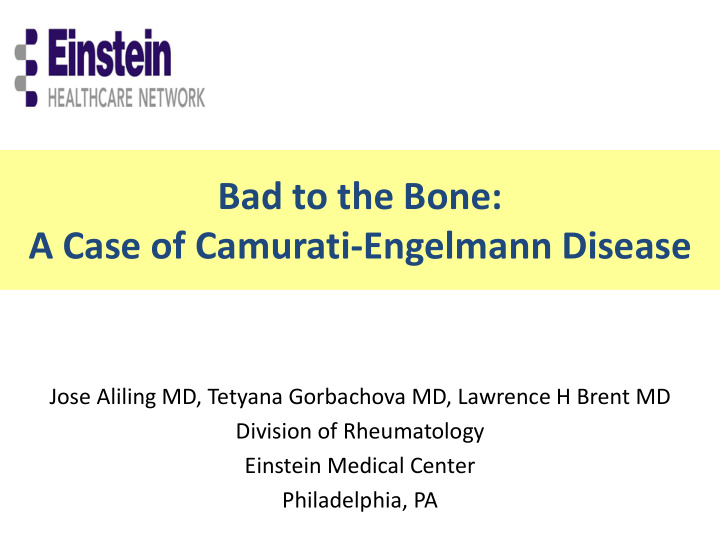



Bad to the Bone: A Case of Camurati-Engelmann Disease Jose Aliling MD, Tetyana Gorbachova MD, Lawrence H Brent MD Division of Rheumatology Einstein Medical Center Philadelphia, PA
Case Presentation A 56 year old African American Female with HIV on HAART presented with pain on both lower limbs • It is associated with an unsteady gait for several years, worsening over the last 2-3 weeks, especially after exercise. • The pain was localized to the thighs, knees, and calf muscles. • The pain initially occurred during the day with weight bearing activities but over time the pain also occurred while at rest and at night. • She recalled suffering from a similar type of pain in the past but has never persisted as long as this episode. She observed that she had become less active and was noted to walk with an unstable gait secondary to the pain. • She denied any significant weight loss or fever.
Physical Exam • T enderness of both quadriceps and calf muscles with no evidence of swelling, warmth or decreased range of motion, • Tenderness on the lateral joint line of both knees with crepitus but no synovitis or effusion. • Muscle strength and deep tendon reflexes in the lower extremities was normal.
Laboratory Data • Hemoglobin was 10.8 gm/dl (normocytic and normochromic) • Normal TSH, LFTs, CPK, and a negative hepatitis panel. • The CD4 count was normal with an undetectable HIV RNA viral load.
Imaging * Axial PD Sag PD Coronal T1 fat sat AP and lateral radiographs of the knee demonstrate widening of the femoral diaphysis with circumferentially thickened cortex (thick arrows) and narrowed medullary canal. MRI depicted both endosteal and periosteal bone B A formation resulting in marked cortical thickening. There is no epiphyseal involvement (thin arrows) and no increased trabeculation of the medullary canal (asterisk), helping to differentiate this appearance from Paget’s disease.
Skeletal Survey
Skeletal Survey
Skeletal Survey
Skeletal Survey • Skeletal survey demonstrates smooth fusiform thickening of the diaphyseal portion of the tubular bones, symmetrical in distribution, with affected bone sharply demarcated form normal bone. • The cortices are sclerotic in appearance with areas of rarefaction. • Note sparing of the metaphyses and epiphyses that is characteristically, but not invariably present in CED.
Case • The clinical findings and characteristic radiologic appearance led to the diagnosis of Camurati-Engelmann disease. • The patient was initially managed with NSAIDs and the patient was lost to follow-up.
Discussion • The diagnosis of Camurati-Engelmann disease is based on the history, physical examination, and radiographic findings. • The diagnosis can be confirmed by genetic testing. Bone and muscle histology are nonspecific. • The hallmark of the disorder is cortical thickening of the diaphysis of the long bones. • Hyperostosis is bilateral and symmetrical and usually starts at the diaphysis of the femuri and tibiae, expanding to the fibulae, humeri, and radii. As the disease progresses, the metaphyses may become affected as well, but the epiphyses are spared. 4
Discussion • TGFB1 is the only gene known to be associated with Camurati-Engelmann disease. • Sequence analysis may identify TGFB1 mutations in 90% of affected individuals and is clinically available. In 10% of cases the cause of the condition is unknown. • Mutations in the TGFB1 gene cause Camurati-Engelmann disease. • TGF- β1 has immunomodulatory properties regulating T cells and B cells including isotype switching, and macrophages, as well as promoting tissue repair after local immune and inflammatory reactions subside by promoting fibroblast growth and collagen production. • In addition TGF- β 1 stimulates osteoblasts and osteoclasts resulting in increased bone production and turnover. 5
Learning Points • The hallmark of the disorder is the cortical thickening of the diaphysis of the long bones. • TGFB1 is the only gene known associated with CED.
References 1. Janssens K, Vanhoenacker F, Bonduelle M, et al. Camurati-Engelmann disease: A review of the clinical, radiologic and molecular data of 24 families and implications for diagnosis and treatment. J Med Genet 2006;43:1-11. 2. Crisp AJ, Brenton DP. Engelmann’s disease of bone - a systemic disorder? Ann Rheum Dis 1982;41:183-8. 3. Hernandez MV, Peris P, Guanabens N, et al. Biochemical markers of bone turnover in Camurati-Engelmann disease: a report on four cases in one family. Calcif Tissue Int 1997;61:48-51. 4. Sparkes RS, Graham CB. Camurati-Engelmann disease. Genetics and clinical manifestations with a review of the literature. J Med Genet 1972;9:73-85. 5. Whyte MP, Totty WG, Novack DV, et al. Camurati-Engelmann disease: Unique variant of novel mutation in TGFβ1 encoding transforming growth factor beta 1 and missense change in TNFSF11 encoding RANK ligand. J. Bone Miner Res 2011;26:920-33 6. Resnick D, Kransdorf M. Bone and Joint Imaging, 3rd Edition, Elsevier- Saunders, 2005.
Recommend
More recommend